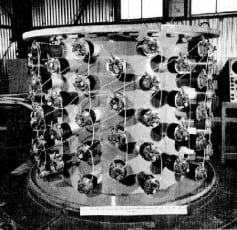Cowan and Reines et al. discover the neutrino experimentally
During the 1950s, physicists Clyde L. Cowan and Frederick Reines conducted a series of experiments to detect the neutrino. They planned to do this using inverse beta decay (one of the interactions also seen by IceCube), in which a neutrino (more specifically an electron antineutrino) interacts with a proton inside an atomic nucleus producing a neutron and a positron.

The idea was to detect neutrinos by looking for the particles it left behind after it interacted with something. They set up an experiment using a tank of water and layers of liquid scintillators that could pick up signals from the secondary particles; a nuclear reactor provided the neutrinos. When a neutrino interacted with a proton in the water tank, the resulting particles would leave signature tracks in the liquid scintillator, revealing the neutrino’s presence.
They first performed the experiment at the Hanford Site in Washington, but the cosmic-ray background muddied their data too much. So they moved to the Savannah River Plant in South Carolina where they had better shielding against cosmic rays—and that’s where they got their definitive results. They were able to identify about three neutrinos per hour in the many months of data they had collected.
The results, which were consistent with the predictions in Fermi’s theory of beta decay, were published in Science in July 1956. Reines was awarded a Nobel Prize in Physics for this experiment in 1995; Cowan died in 1974 and was thus ineligible.
Read more about it here, here, here, and here.
